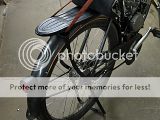Internally geared hubs are not known for their strength and even with human power only certain minimum gear-up ratios are required between the rear gear hub sprocket and the chain ring on the pedals especially with tandem bikes where there are two people pedaling together and putting twice the torque on the hub.
The older heavier Nu-Vinci variable hubs that were built heavier and had a 350% range instead of the lighter built newer Nu-Vinci hubs with their slightly wider 360% range (new N360 model) have been used in both electric and internal combustion builds successfully but the motors used were of the smaller lower power weed-eater type that were less then 50cc and less then 2-hp. I'm not familiar with anyone using the newer N360 hubs for gasoline engine powered bikes and I don't think they would stand up to it, this based on that fact that electric powered builds above 500-watts are not recommended for the new lighter built N360 hubs and failures have been reported with 1,000-watt and higher set-ups using them which is about 1.34 horsepower. A supped up 66cc like you have in mind is probably going to put out 3 horsepower or more and is probably too much for a Nu-Vinci even the older heavier duty ones (assuming you could pick one of them up) and the Nu-Vinci hub is considered one of the best internal gear hubs that can take the most torque by those in the electric assisted bike world (do some reading on the endless sphere forum if you really want to figure out what works and what doesn't for high power builds and then just apply what those guys learned to your internal combustion powered build).
If I were going to try to do a build like you suggest I think I would go either one of three ways:
Option #1 ----- Use a heavy duty rear cassette free-hub specifically built for use on a tandem bike that is compatible with the Shimano rear cassette hub splines and then put an 8 speed cassette on it that used a lock ring rather then a lock cog. An 8 speed cassette is as many cogs as you can go in the back without having to switch to a narrow and weaker chain then a normal bike chain (9, 10, & 11 speed cassettes all use progressively thinner and weaker chains and sprockets). Then I would use a good quality mountain bike derailer on the rear, not one of those junky cheap rear derailers a good quality one.
Option #2 ----- Order a "Yuba Mondu" rear wheel and hub assembly (a heavy duty long tail cargo bike rated to haul up to a 1/4 ton of weight on the rear wheel that has a hybrid hub that uses the thicker heavier duty axle and bearings of a BMX trick bike hub on a 48 spoke rear wheel with the right drop out spacing to allow the use of a multi-speed freewheel) and then look real hard on e-bay for one of the 80's era high end heavy duty race bike English threaded freewheel assemblies preferably one of the fully serviceable ones and screw that onto the heavy duty Yuba rear wheel assembly and then once again use a quality derailer.
Option #3 ----- Truth be told for an internal combustion motorized bicycle you really only need two gears provided both the pedals and the motor work through those gears together with the motor and pedals geared to match their disassociate RPM operating range. One low gear for starting from a dead stop and climbing steep hills and a high gear for traveling at speed on the flat. Take a good look at the model #200 bike on the top of the bike page at sportsmanflyer.com notice how the rear wheel has two heavy duty sprockets using heavy chain on it. One smaller diameter one on the right hand side and one larger diameter one on the left side of the wheel. As it is the right side is driven by the pedals and the left side is driven by the motor through a double reduction. What if both sides were driven by both the motor and the pedals with a double clutch assembly to switch drive sides in the bottom bracket so that when in low gear both the pedals and the motor drove the large sprocket on the left side of the tire and gave a low strong gear and then when in high gear the pedals and the motor drop the smaller sprocket on the right side of the tire giving a high speed gear? Wouldn't that make a sweet set-up? And using two thick strong sprockets with heavy weight chain would be a lot stronger and less problem prone then any gearing system that used lighter weight bicycle chain and sprockets.









